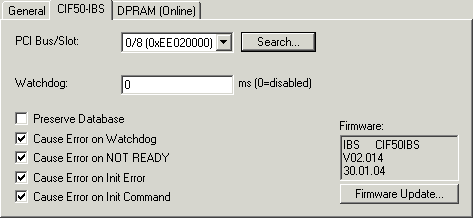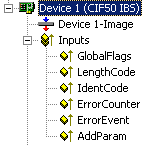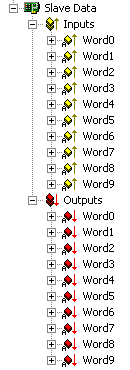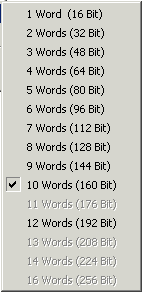Hilscher CIF50-IBS
System requirements:
- TwinCAT 2.9 build > 1000 and higher.
The CIF50-IBS is an Interbus-S slave PCI card with 8 kB DPRAM. Supported baud rates: 500kBit and 2MBit. The baud rate can be configured via a DIP switch on the card. The new baud rate will only apply after a system restart (power OFF). The slave card is offered in two versions, i.e. with copper or optical fibre fieldbus interface. TwinCAT configuration is identical in both cases.
"CIF50-IBS" tab

Preserve Database: If this option is selected, the static (FLASH) configuration is not cleared when TwinCAT is started. Default: Not selected.
PCI Bus/Slot: Indicates in which logical PCI slot the card was found.
Search: This option enables any CIF50-IBS cards installed in the computer to be identified.
Firmware Update: Enables a firmware update to be carried out.
Watchdog: Watchdog time in ms. Default: 0 ms (deactivated).
Generation of the module error at the Interbus master can be configured via the following options:
Cause Error on Watchdog: The watchdog monitoring should send a module error to the master. The watchdog time must be set to a value <> 0. After a TwinCAT stop, a module error is sent to the master once the watchdog time has elapsed. Default: Selected.
Cause Error on NOT READY: A module error is sent to the master if the slave is in NOT READY state. During a TwinCAT stop, the slave is set to NOT READY state. Default: Selected.
Cause Error on Init Error: A module error is sent to the master if an error occurs during initialisation. Default: Selected.
Cause Error on Init Command: A module error is sent to the master after an initialization command. Default: Selected.
The module error enables the master to detect the state of the slave card.
CIF50-IBS diagnostic inputs

The CIF50-IBS automatically has 8 input bytes describing the state of card and the Interbus:
GlobalFlags: The individual bits have the following definitions:
- 0x01 = Bus Active (0 = Bus not active)
- 0x02 = Data Exchange Active (0 = No data exchange)
- 0x04 = PCP Communication Established (0 = No PCP communication)
- 0x08 = Initialization Error Detected (0 = No initialization fault)
- 0x10 = Runtime Error Detected (0 = No runtime error)
- 0x20 = Application is in 'NotReady' State (0 = System running)
Via these flags the slave application can detect the state of the InterBus (master). During data exchange with the master, the bits Bus Active and Data Exchange Active are set. If the master is not configured, the bit Application is in 'NotReady' State may be set.
LengthCode: Shows the current length code of the slave module. Default: 21 ( = 10 words input and output process data length).
IdentCode: Shows the current ID code of the slave module. Default: Digital I/O slave ( ID code = 0x03 ).
ErrorCounter: Number of errors detected since the module was switched on.
EventError: Error code of the last detected error. See CIF50-IBS error codes.
AddParam: Additional error code parameters (optional). See CIF50-IBS error codes.
CIF50-IBS slave data (slave process data)

The length of the process data can be configured via the "Slave Data" context menu.
"Slave Data" context menu
Right-clicking on "Slave Data" in the configuration tree brings up the following menu:

Prozess Data Width: Can be used to configure the length of the slave process data.

PCP Channel: PCP communication is currently not supported.

The following process data lengths can be configured:
Slave length code | Real data width of the Slave in Bytes (Words) |
|---|---|
1 | 2 (1) |
2 | 4 (2) |
3 | 6 (3) |
4 | 8 (4) |
5 | 10 (5) |
6 | 16 (8) |
7 | 18 (9) |
14 | 12 (6) |
15 | 14 (7) |
21 | 20 (10) |
22 | 24 (12) |
System behavior of the CIF50-IBS within a TwinCAT system
In order to be able to operate the card as an Interbus-S slave with an Interbus master, it has to be configured (initialized) first. The card configuration can be stored in a static flash or a non-static memory. If present, the static configuration has a higher priority and is loaded first when the power supply is switched on. In order to be able to load a non-static configuration, the existing static configuration has to be deleted first.
Notice | |
The static (flash) configuration can only be loaded with the SyCon configuration software. With TwinCAT System Manager, only the non-static configuration can be loaded. The TwinCAT software will delete any existing static configuration. The slave card only retains the non-static configuration until it is de-energized (e.g. PC switched off and external power supply OFF). |
The slave card can also be supplied from an external 24V supply. The external power supply can only be used if the additional COP 50-EPS module is connected with the card. The external power supply ensures that the slave card retains its non-static configuration if the PC is switched off. In the event that this power supply is also interrupted and no static configuration is loaded, the card has to be re-configured. A non-configured slave card will report an initialization error to the master. The master configuration cannot be activated and data exchange cannot be started (the non-initialized slave segment can initially be switched off in the master configuration and subsequently (once initialized) be switched on).